水污染与治理英文论文
- 格式:docx
- 大小:18.16 KB
- 文档页数:3
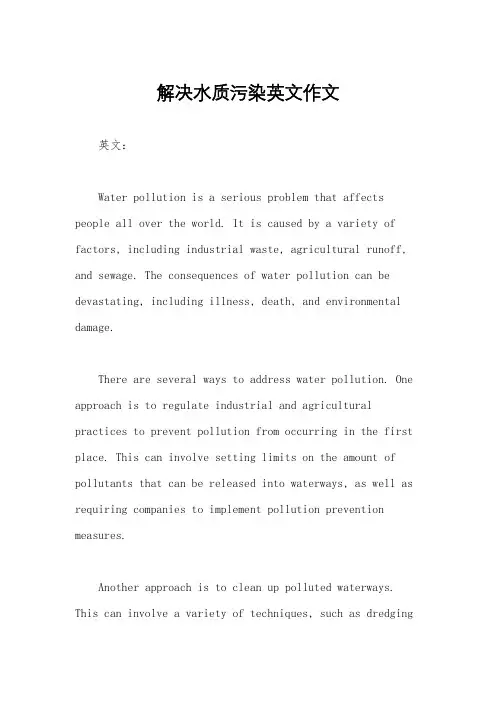
解决水质污染英文作文英文:Water pollution is a serious problem that affects people all over the world. It is caused by a variety of factors, including industrial waste, agricultural runoff, and sewage. The consequences of water pollution can be devastating, including illness, death, and environmental damage.There are several ways to address water pollution. One approach is to regulate industrial and agricultural practices to prevent pollution from occurring in the first place. This can involve setting limits on the amount of pollutants that can be released into waterways, as well as requiring companies to implement pollution prevention measures.Another approach is to clean up polluted waterways. This can involve a variety of techniques, such as dredgingcontaminated sediments, installing treatment systems, and planting vegetation to help absorb pollutants.In addition to these approaches, individuals can also take steps to help prevent water pollution. For example, we can reduce our use of chemicals and pesticides, properly dispose of hazardous waste, and conserve water.Overall, addressing water pollution requires a multi-faceted approach that involves government regulation, industry practices, and individual actions. By working together, we can help ensure that our waterways remain clean and safe for generations to come.中文:水质污染是一个严重的问题,影响着全世界的人们。
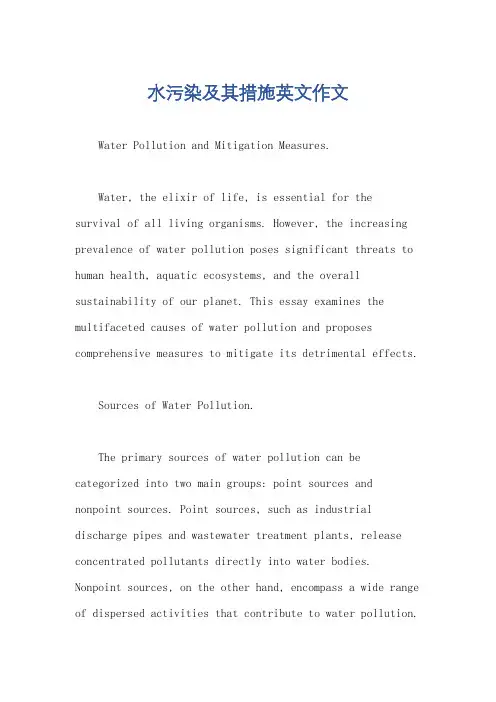
水污染及其措施英文作文Water Pollution and Mitigation Measures.Water, the elixir of life, is essential for thesurvival of all living organisms. However, the increasing prevalence of water pollution poses significant threats to human health, aquatic ecosystems, and the overall sustainability of our planet. This essay examines the multifaceted causes of water pollution and proposes comprehensive measures to mitigate its detrimental effects.Sources of Water Pollution.The primary sources of water pollution can be categorized into two main groups: point sources and nonpoint sources. Point sources, such as industrial discharge pipes and wastewater treatment plants, release concentrated pollutants directly into water bodies. Nonpoint sources, on the other hand, encompass a wide range of dispersed activities that contribute to water pollution.Examples include agricultural runoff carrying fertilizers and pesticides, stormwater discharge from urban areas, and septic tank seepage.Consequences of Water Pollution.The consequences of water pollution are far-reaching and multifaceted. Contaminated water poses serious health risks to humans who consume it, leading to diseases such as diarrhea, cholera, and typhoid fever. Aquatic ecosystems are also severely compromised by water pollution, as it disrupts food chains, reduces biodiversity, and impairs the ability of aquatic organisms to reproduce. Furthermore, water pollution can damage infrastructure, diminish aesthetic appeal, and hinder recreational activities.Mitigation Measures.Mitigating water pollution requires a multi-pronged approach that addresses both point and nonpoint sources.Point Source Control.Industrial Wastewater Treatment: Industries must implement effective wastewater treatment systems to remove pollutants before releasing waste into water bodies.Municipal Wastewater Treatment: Municipalities should upgrade and expand their wastewater treatment plants to meet the growing demand and improve treatment efficiency.Enforcement of Regulations: Strict enforcement of environmental regulations and penalties for non-compliance is crucial to deter polluters.Nonpoint Source Control.Agricultural Best Management Practices: Farmers should adopt sustainable agricultural practices, such as using cover crops, reducing fertilizer and pesticide application, and implementing erosion control measures.Urban Stormwater Management: Cities and towns need to invest in green infrastructure, such as rain gardens andpermeable pavements, to reduce stormwater runoff and capture pollutants.Septic Tank Management: Proper maintenance and inspection of septic tanks prevent leakage and ensure proper wastewater treatment.Other Measures.Public Awareness and Education: Raising awareness about the causes and consequences of water pollution is vital for encouraging responsible behavior and fostering a culture of water conservation.Research and Innovation: Ongoing research and development of new technologies and approaches can improve water treatment efficiency and reduce pollution sources.International Cooperation: Water pollution often transcends national boundaries, necessitating international collaboration to address transboundary issues and share best practices.Conclusion.Water pollution is a global crisis that demands urgent and comprehensive action. By implementing effective point and nonpoint source control measures, raising public awareness, and fostering international cooperation, we can protect this precious resource for future generations. The time for complacency has passed; the time for action is now. Let us work together to ensure that water, the source ofall life, remains a vital and sustainable asset for all.。
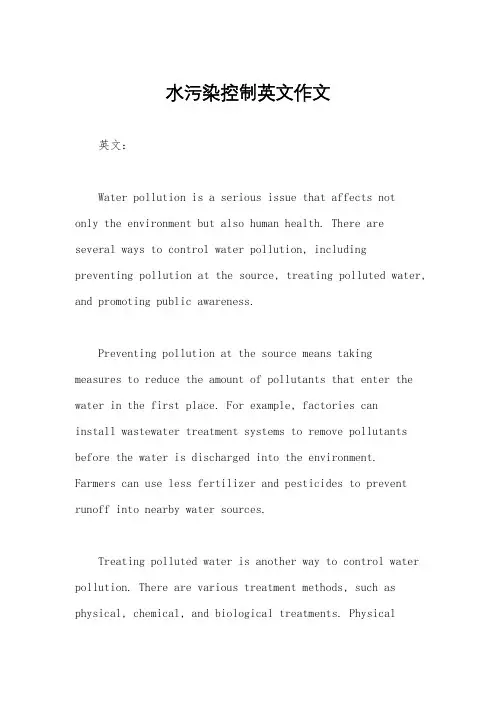
水污染控制英文作文英文:Water pollution is a serious issue that affects notonly the environment but also human health. There are several ways to control water pollution, including preventing pollution at the source, treating polluted water, and promoting public awareness.Preventing pollution at the source means taking measures to reduce the amount of pollutants that enter the water in the first place. For example, factories caninstall wastewater treatment systems to remove pollutants before the water is discharged into the environment. Farmers can use less fertilizer and pesticides to prevent runoff into nearby water sources.Treating polluted water is another way to control water pollution. There are various treatment methods, such as physical, chemical, and biological treatments. Physicaltreatments involve removing pollutants by filtration or sedimentation. Chemical treatments involve adding chemicals to the water to remove pollutants. Biological treatments use microorganisms to break down pollutants.Promoting public awareness is also important in controlling water pollution. People need to understand the impact of their actions on the environment and the importance of protecting water sources. For example, individuals can reduce their water usage, properly dispose of hazardous waste, and avoid littering.In conclusion, controlling water pollution requires a multi-faceted approach. Preventing pollution at the source, treating polluted water, and promoting public awareness are all important strategies in protecting our water sources and ensuring a healthy environment.中文:水污染是一个严重的问题,不仅影响环境,也影响人类健康。
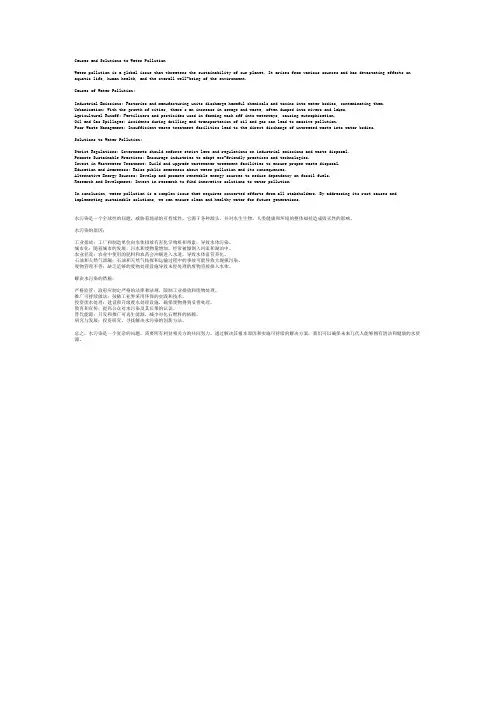
Causes and Solutions to Water PollutionWater pollution is a global issue that threatens the sustainability of our planet. It arises from various sources and has devastating effects on aquatic life, human health, and the overall well-being of the environment.Causes of Water Pollution:Industrial Emissions: Factories and manufacturing units discharge harmful chemicals and toxins into water bodies, contaminating them. Urbanization: With the growth of cities, there's an increase in sewage and waste, often dumped into rivers and lakes.Agricultural Runoff: Fertilizers and pesticides used in farming wash off into waterways, causing eutrophication.Oil and Gas Spillages: Accidents during drilling and transportation of oil and gas can lead to massive pollution.Poor Waste Management: Insufficient waste treatment facilities lead to the direct discharge of untreated waste into water bodies.Solutions to Water Pollution:Strict Regulations: Governments should enforce strict laws and regulations on industrial emissions and waste disposal.Promote Sustainable Practices: Encourage industries to adopt eco-friendly practices and technologies.Invest in Wastewater Treatment: Build and upgrade wastewater treatment facilities to ensure proper waste disposal.Education and Awareness: Raise public awareness about water pollution and its consequences.Alternative Energy Sources: Develop and promote renewable energy sources to reduce dependency on fossil fuels.Research and Development: Invest in research to find innovative solutions to water pollution.In conclusion, water pollution is a complex issue that requires concerted efforts from all stakeholders. By addressing its root causes and implementing sustainable solutions, we can ensure clean and healthy water for future generations.水污染是一个全球性的问题,威胁着地球的可持续性。
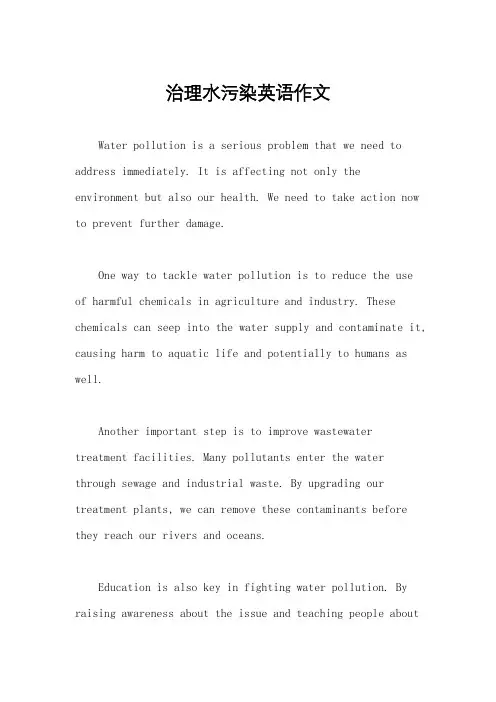
治理水污染英语作文Water pollution is a serious problem that we need to address immediately. It is affecting not only the environment but also our health. We need to take action now to prevent further damage.One way to tackle water pollution is to reduce the useof harmful chemicals in agriculture and industry. These chemicals can seep into the water supply and contaminate it, causing harm to aquatic life and potentially to humans as well.Another important step is to improve wastewater treatment facilities. Many pollutants enter the water through sewage and industrial waste. By upgrading our treatment plants, we can remove these contaminants before they reach our rivers and oceans.Education is also key in fighting water pollution. By raising awareness about the issue and teaching people aboutthe importance of clean water, we can encourage individuals to take action in their own lives to reduce pollution.Government regulations play a crucial role in controlling water pollution. Strong laws and enforcement mechanisms are necessary to hold polluters accountable and ensure that they are taking steps to reduce their environmental impact.In addition to these measures, we also need to invest in research and innovation to find new ways to clean up polluted water and prevent further contamination. By supporting scientific advancements in this area, we can develop more effective solutions to protect our water resources for future generations.。
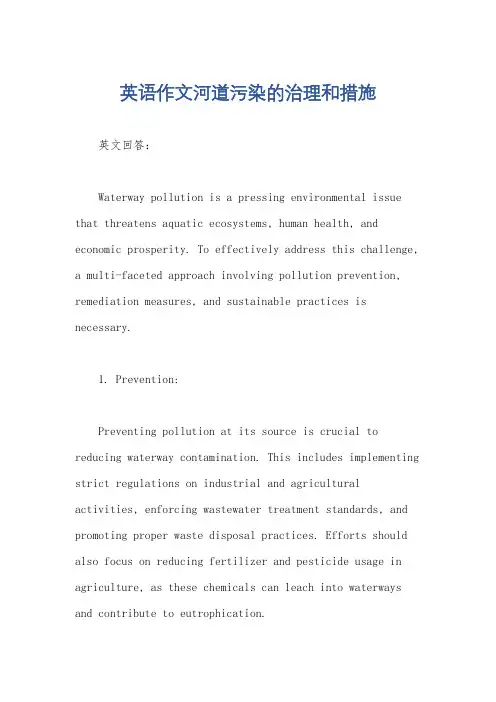
英语作文河道污染的治理和措施英文回答:Waterway pollution is a pressing environmental issue that threatens aquatic ecosystems, human health, and economic prosperity. To effectively address this challenge, a multi-faceted approach involving pollution prevention, remediation measures, and sustainable practices is necessary.1. Prevention:Preventing pollution at its source is crucial to reducing waterway contamination. This includes implementing strict regulations on industrial and agricultural activities, enforcing wastewater treatment standards, and promoting proper waste disposal practices. Efforts should also focus on reducing fertilizer and pesticide usage in agriculture, as these chemicals can leach into waterways and contribute to eutrophication.2. Remediation:Remediation measures aim to clean up existing pollution in waterways. Physical and biological methods, such as dredging and bioremediation, can remove pollutants and restore water quality. Additionally, wetland restoration and riparian buffer zones can trap pollutants, provide habitat for aquatic life, and help stabilize riverbanks.3. Sustainable Practices:Adopting sustainable practices can minimize future pollution and protect waterways. Green infrastructure, such as bioswales and rain gardens, collects and filters stormwater runoff before it enters waterways, reducing sedimentation and nutrient loading. Low-impact development approaches, including permeable pavements and green roofs, also contribute to reducing runoff and improving water quality.4. Monitoring and Enforcement:Regular water quality monitoring is essential to track pollution levels and identify areas of concern. Enforcement measures, such as fines and penalties, deter polluters and ensure compliance with regulations. Collaborative efforts between government agencies, industry, and the public are crucial for effective monitoring and enforcement.中文回答:河道污染的治理和措施。
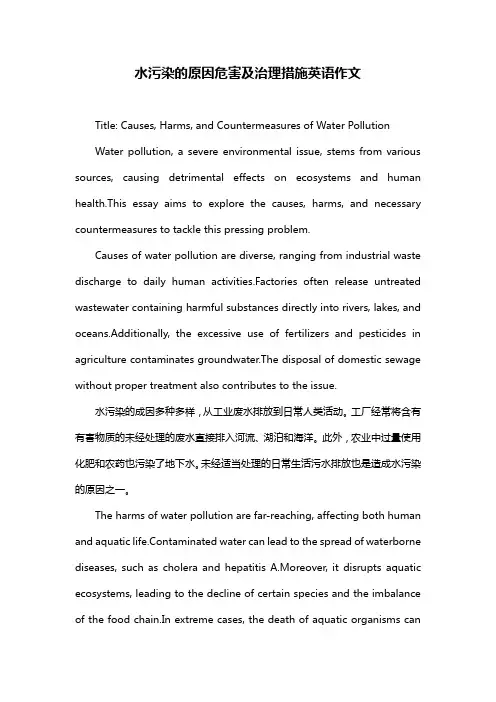
水污染的原因危害及治理措施英语作文Title: Causes, Harms, and Countermeasures of Water PollutionWater pollution, a severe environmental issue, stems from various sources, causing detrimental effects on ecosystems and human health.This essay aims to explore the causes, harms, and necessary countermeasures to tackle this pressing problem.Causes of water pollution are diverse, ranging from industrial waste discharge to daily human activities.Factories often release untreated wastewater containing harmful substances directly into rivers, lakes, and oceans.Additionally, the excessive use of fertilizers and pesticides in agriculture contaminates groundwater.The disposal of domestic sewage without proper treatment also contributes to the issue.水污染的成因多种多样,从工业废水排放到日常人类活动。
工厂经常将含有有害物质的未经处理的废水直接排入河流、湖泊和海洋。
此外,农业中过量使用化肥和农药也污染了地下水。
未经适当处理的日常生活污水排放也是造成水污染的原因之一。
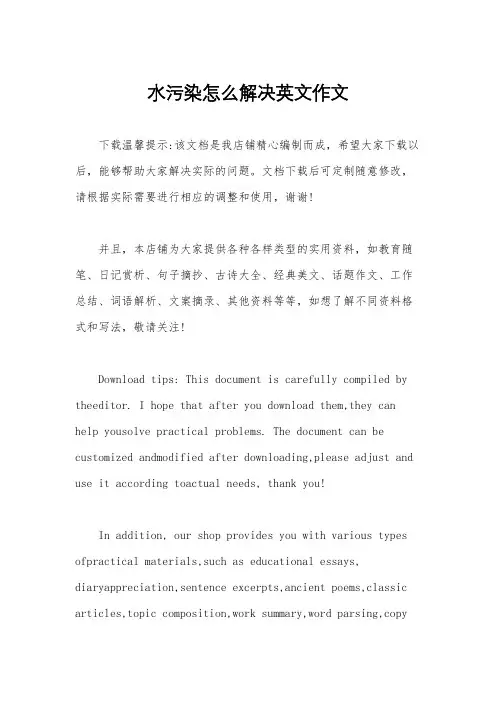
水污染怎么解决英文作文下载温馨提示:该文档是我店铺精心编制而成,希望大家下载以后,能够帮助大家解决实际的问题。
文档下载后可定制随意修改,请根据实际需要进行相应的调整和使用,谢谢!并且,本店铺为大家提供各种各样类型的实用资料,如教育随笔、日记赏析、句子摘抄、古诗大全、经典美文、话题作文、工作总结、词语解析、文案摘录、其他资料等等,如想了解不同资料格式和写法,敬请关注!Download tips: This document is carefully compiled by theeditor. I hope that after you download them,they can help yousolve practical problems. The document can be customized andmodified after downloading,please adjust and use it according toactual needs, thank you!In addition, our shop provides you with various types ofpractical materials,such as educational essays, diaryappreciation,sentence excerpts,ancient poems,classic articles,topic composition,work summary,word parsing,copyexcerpts,other materials and so on,want to know different data formats andwriting methods,please pay attention!Water pollution is a big problem. We need to take action. We can start by reducing the amount of waste we put into the water. For example, we should recycle and reuse as much as possible.Another thing we can do is to be more careful with chemicals. We should use eco-friendly products and avoid using harmful ones that can end up in the water.Governments should also play a role. They should make stricter laws and regulations to control pollution. And they should enforce these laws properly.Everyone can contribute. We can raise awareness about the importance of clean water and encourage others to do the same. Small actions by many people can make a big difference.。
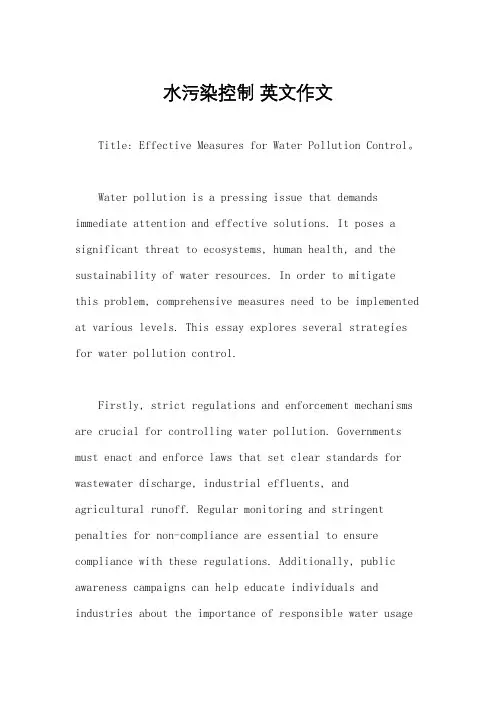
水污染控制英文作文Title: Effective Measures for Water Pollution Control。
Water pollution is a pressing issue that demands immediate attention and effective solutions. It poses a significant threat to ecosystems, human health, and the sustainability of water resources. In order to mitigatethis problem, comprehensive measures need to be implemented at various levels. This essay explores several strategies for water pollution control.Firstly, strict regulations and enforcement mechanisms are crucial for controlling water pollution. Governments must enact and enforce laws that set clear standards for wastewater discharge, industrial effluents, andagricultural runoff. Regular monitoring and stringent penalties for non-compliance are essential to ensure compliance with these regulations. Additionally, public awareness campaigns can help educate individuals and industries about the importance of responsible water usageand pollution prevention.Secondly, investment in wastewater treatment infrastructure is essential for reducing water pollution. Treatment plants equipped with advanced technologies can effectively remove pollutants from wastewater before it is discharged into water bodies. Governments and private sector entities should collaborate to invest in the construction and maintenance of these facilities. Moreover, decentralized treatment systems can be implemented in areas where centralized infrastructure is not feasible, ensuring that even remote communities have access to clean water.Furthermore, promoting sustainable agricultural practices is critical for preventing water pollution. Excessive use of fertilizers and pesticides can lead to runoff pollution, contaminating rivers and lakes with harmful chemicals. By promoting organic farming methods, crop rotation, and precision agriculture techniques, farmers can minimize the environmental impact of their activities. Subsidies and incentives can encourage farmers to adopt these practices, thereby reducing agriculturalpollution.In addition to regulatory measures and infrastructure investments, ecosystem restoration projects can helpmitigate the effects of water pollution. Wetlands, riparian buffers, and other natural habitats play a crucial role in filtering pollutants and improving water quality. Restoring degraded ecosystems not only enhances biodiversity but also provides valuable ecosystem services such as flood control and water purification.Moreover, international cooperation is essential for addressing transboundary water pollution issues. Manyrivers and lakes cross national borders, making pollution control a shared responsibility among neighboring countries. Bilateral and multilateral agreements can facilitate collaboration on monitoring, data sharing, and pollution prevention efforts. By working together, nations can effectively address the root causes of water pollution and protect shared water resources.In conclusion, water pollution is a complex andmultifaceted problem that requires concerted efforts from governments, industries, communities, and individuals. By implementing strict regulations, investing in wastewater treatment infrastructure, promoting sustainable agriculture, restoring ecosystems, and fostering international cooperation, we can effectively control water pollution and ensure the availability of clean water for future generations. Only through collective action and commitment can we address this critical environmental challenge.。

水污染治理作文英文Water pollution is a growing concern in today's world. It not only affects the environment but also poses a threat to human health. To tackle this issue, effective measures need to be taken.One way to address water pollution is through stricter regulations on industrial waste disposal. Industries should be held accountable for their actions and be required to treat their wastewater before releasing it into rivers or oceans. This would help prevent harmful chemicals and toxins from contaminating our water sources.Another approach is to promote sustainable farming practices. The use of pesticides and fertilizers in agriculture contributes to water pollution. Encouraging farmers to adopt organic farming methods and reduce the use of chemicals can significantly reduce the amount of pollutants entering our water systems.In addition, raising public awareness about water pollution is crucial. Education campaigns can help people understand the importance of clean water and the consequences of pollution. By informing individuals about simple actions they can take, such as properly disposing of household chemicals and conserving water, we can all contribute to reducing water pollution.Investing in advanced water treatment technologies is also essential. Developing innovative methods to purify water and remove pollutants can help ensure a clean and safe water supply. Governments and organizations should allocate funds to research and implement these technologies on a large scale.Furthermore, collaboration between countries is vitalin addressing water pollution. Many water bodies, such as rivers and lakes, cross national borders. Therefore, international cooperation is necessary to regulate and manage shared water resources. By working together, countries can develop strategies and policies to prevent pollution and protect these valuable water sources.Lastly, individuals should take responsibility fortheir actions and make conscious choices to reduce water pollution. Simple actions like using eco-friendly cleaning products, conserving water, and properly disposing of waste can make a significant difference. Each person has the power to contribute to a cleaner environment and ensure a sustainable future.In conclusion, water pollution is a pressing issue that requires immediate attention. By implementing stricter regulations, promoting sustainable practices, raising awareness, investing in technology, fostering international cooperation, and encouraging individual actions, we can effectively combat water pollution and safeguard our precious water resources.。

治理水污染英语作文Tackling Water Pollution: A Global Challenge。
Water, the essence of life, sustains all forms of existence on our planet. However, the increasing severity of water pollution poses a grave threat to our environment and public health. Therefore, it is imperative that we take concerted actions to address this issue effectively.Water pollution is a complex phenomenon, stemming from various sources such as industrial waste, agricultural runoff, urban sewage, and even oil spills. These contaminants find their way into our rivers, lakes, oceans, and groundwater, altering the natural balance of aquatic ecosystems. The resulting degradation of water quality can have devastating effects, including the death of aquatic life, the degradation of drinking water sources, and an increased risk of water-borne diseases.To combat water pollution, a multifaceted approach isnecessary. Firstly, stringent regulations must be implemented to limit the discharge of harmful substances into water bodies. Industries and agricultural sectors must be required to adopt cleaner production methods and waste management practices. Additionally, urban areas should improve their sewage treatment facilities to ensure that wastewater is properly treated before being released into the. environment。
治理水污染英语作文Water pollution is a serious issue that we cannot ignore. It's essential to take action to protect our water resources and ensure a clean and safe environment for everyone.One of the biggest causes of water pollution is industrial waste. Factories and manufacturing plants often release harmful chemicals into rivers and lakes, contaminating the water and making it unsafe for drinking or swimming. We need to enforce stricter regulations on these industries to reduce their waste and ensure they're properly disposing of it.Another common source of water pollution is agricultural runoff. Fertilizers and pesticides used on farms can wash into nearby water bodies, polluting the water and affecting aquatic life. We can encourage farmers to adopt more sustainable farming practices, like using organic fertilizers and natural pest control methods, tohelp reduce this pollution.Individual actions can also help in the fight against water pollution. Simple things like not littering and properly disposing of waste can prevent pollutants from entering our waterways. We can also conserve water by fixing leaks and being mindful of our usage, reducing the demand for treated water and thus reducing the amount of pollutants released into the environment.Education is also key in the battle against water pollution. People need to understand the importance of clean water.。
减少水污染的办法英文作文Here is an 800-word English essay on ways to reduce water pollution:Reducing Water Pollution: Strategies for a Cleaner Future。
Water is one of our most precious natural resources, essential for sustaining life on our planet. However, the increasing prevalence of water pollution poses a significant threat to the health and well-being of both humans and the environment. As we grapple with the consequences of industrialization, urbanization, and unsustainable practices, it is crucial that we take proactive steps to address this pressing issue.One of the primary contributors to water pollution is the discharge of untreated industrial effluents. Many manufacturing and processing facilities often release harmful chemicals, heavy metals, and other contaminantsdirectly into nearby water bodies, without proper treatment. To mitigate this, governments and regulatory bodies must enforce stricter regulations and monitoring systems to ensure that industries adhere to strict environmental standards. This can include mandating the installation of wastewater treatment plants, imposing hefty fines for non-compliance, and providing incentives for companies to adopt cleaner production methods.Another significant source of water pollution is the runoff of agricultural chemicals, such as fertilizers and pesticides, from farmlands. These substances can seep into groundwater, rivers, and lakes, disrupting aquatic ecosystems and posing a threat to human health. Farmers can play a crucial role in addressing this issue by adopting sustainable agricultural practices, such as integrated pest management, precision farming, and the use of organic fertilizers. Governments can also support these efforts by offering subsidies, training programs, and technical assistance to farmers who implement environmentally-friendly farming methods.Urbanization and the growth of human settlements have also contributed to the rise of water pollution. Untreated sewage, household waste, and storm water runoff often find their way into nearby water bodies, leading to the contamination of drinking water sources and the degradation of aquatic habitats. To tackle this problem, municipalities must invest in the construction and maintenance ofefficient sewage treatment facilities, as well as the implementation of effective storm water management systems. Additionally, public awareness campaigns and educational programs can encourage citizens to adopt eco-friendly practices, such as proper waste disposal and the reductionof water consumption.The improper disposal of solid waste, including plastics, is another significant contributor to water pollution. When these materials end up in waterways, they can harm aquatic life, disrupt food chains, and even make their way into the human food supply. To address this issue, governments and communities must promote and facilitate the proper disposal and recycling of waste. This can includethe implementation of comprehensive waste managementsystems, the banning of single-use plastics, and the development of innovative recycling technologies.Furthermore, the extraction and processing of fossil fuels can also lead to water pollution, as spills, leaks, and improper disposal of waste products can contaminate water sources. To mitigate this, the energy industry must adopt more stringent environmental safeguards, invest in cleaner technologies, and ensure the proper containment and treatment of all waste products.Finally, individual actions can also play a crucialrole in reducing water pollution. By making conscious choices to conserve water, reduce waste, and support environmentally-friendly products and services, citizens can contribute to the collective effort to protect our water resources. Simple actions, such as turning off taps when not in use, choosing eco-friendly cleaning products, and properly disposing of hazardous waste, can have a significant impact when multiplied across communities.In conclusion, addressing the challenge of waterpollution requires a multifaceted approach that involves the collaboration of governments, industries, communities, and individuals. By implementing stricter regulations, promoting sustainable practices, investing in infrastructure, and fostering public awareness, we can work towards a future where our water resources are protected and preserved for generations to come. The time to act is now, as the health of our planet and the well-being of all living beings depend on our ability to safeguard this precious resource.。
英语作文-水污染防治与生态修复技术创新Water pollution has become a major environmental issue in recent years, posing a serious threat to human health and the ecosystem. In order to effectively prevent and control water pollution, as well as restore the ecological balance, innovative technologies are essential.One of the key approaches to preventing water pollution is to implement advanced wastewater treatment technologies. Traditional methods such as sedimentation, filtration, and disinfection have limitations in removing certain pollutants, such as heavy metals and organic compounds. Therefore, innovative technologies such as membrane bioreactors, advanced oxidation processes, and electrochemical treatment have been developed to achieve higher removal efficiencies for various pollutants. These advanced technologies not only improve the quality of treated wastewater but also reduce the environmental impact of discharge.In addition to wastewater treatment, the development of eco-friendly materials and techniques for pollution control is also crucial. For example, the use of natural adsorbents such as activated carbon, zeolites, and biochar can effectively remove pollutants from water bodies. Furthermore, the application of phytoremediation, which utilizes plants to absorb and accumulate pollutants, has shown great potential in restoring contaminated water and soil. These innovative approaches not only provide sustainable solutions for pollution control but also contribute to the conservation of natural resources.Moreover, the integration of smart monitoring and management systems plays a significant role in water pollution prevention and control. Real-time monitoring of water quality parameters, such as pH, dissolved oxygen, and nutrient levels, enables early detection of pollution incidents and prompt response measures. Furthermore, the use of remote sensing technology and geographic information systems allows for the assessment of water pollution sources and the identification of critical areas for targeted interventions. By leveraging the power of data and technology, decision-makers can make informed choices and implement effective measures to address water pollution issues.Furthermore, ecological restoration and habitat conservation are essential for the sustainable management of water resources. Wetland restoration, riverbank stabilization, and reforestation are effective measures to improve water quality, enhance biodiversity, and mitigate the impacts of pollution. By restoring natural ecosystems and creating green infrastructure, the resilience of aquatic environments can be strengthened, providing long-term benefits for both humans and wildlife.In conclusion, the prevention and control of water pollution, as well as the restoration of ecological balance, require continuous innovation and the application of advanced technologies. By integrating cutting-edge wastewater treatment, eco-friendly materials, smart monitoring systems, and ecological restoration practices, we can effectively combat water pollution and safeguard the health of our planet. It is imperative for stakeholders to collaborate and invest in innovative solutions to address the challenges of water pollution and ensure a sustainable future for generations to come.。
解决水污染的办法英语作文全文共3篇示例,供读者参考篇1With the rapid industrialization and urbanization, water pollution has become a severe environmental issue worldwide. Water pollution not only affects aquatic ecosystems but also poses a threat to human health. Therefore, it is crucial to find effective solutions to combat water pollution. In this essay, I will discuss several methods to address water pollution and protect our precious water resources.The first and foremost solution to tackle water pollution is to implement stricter regulations and enforcement. Governments should establish and enforce laws and regulations to control the discharge of pollutants into water bodies. Industries should be required to treat their wastewater before releasing it into rivers or oceans. Additionally, penalties for violating environmental regulations should be increased to deter polluters from committing further environmental harm. By enforcing strict regulations, we can prevent water pollution at the source and protect our water resources.Another effective way to address water pollution is to promote sustainable practices in agriculture. Farmers should be encouraged to adopt practices that reduce the use of chemical fertilizers and pesticides, which are major sources of water pollution. Implementing organic farming methods, rotating crops, and using natural fertilizers can help prevent agricultural runoff from contaminating water bodies. By promoting sustainable agriculture, we can minimize the impact of farming activities on water quality and protect our water resources for future generations.In addition to regulations and sustainable practices, investing in wastewater treatment infrastructure is essential to combat water pollution. Municipalities should upgrade and expand their wastewater treatment plants to ensure that sewage is properly treated before being discharged into water bodies. Advanced treatment technologies, such as membrane filtration and ultraviolet disinfection, can remove a wide range of pollutants from wastewater and improve water quality. By investing in wastewater treatment infrastructure, we can reduce the amount of pollutants entering our water bodies and maintain clean and healthy water resources.Furthermore, public awareness and education play a vital role in addressing water pollution. People should be educated about the causes and effects of water pollution, as well as the ways they can contribute to its prevention. Simple actions, such as properly disposing of household chemicals, picking up litter, and conserving water, can have a significant impact on reducing water pollution. By raising public awareness and promoting environmental education, we can empower individuals to take action and protect our water resources.In conclusion, water pollution is a pressing environmental issue that requires immediate action. By implementing stricter regulations, promoting sustainable practices, investing in wastewater treatment infrastructure, and raising public awareness, we can effectively address water pollution and safeguard our water resources. It is essential for governments, industries, and individuals to work together to protect our precious water bodies for present and future generations. Only by taking collective action can we ensure clean and healthy water for all.篇2Water pollution is a growing problem around the world, caused by various factors such as industrial waste, agriculturalrunoff, and improper disposal of garbage. The contamination of water sources poses a serious threat to the environment, public health, and aquatic life. Therefore, it is crucial to take immediate action to address this issue and work towards solutions to resolve water pollution.One of the key solutions to combat water pollution is to implement strict regulations and policies on industries and businesses that release harmful chemicals and waste into water bodies. Governments should enforce laws that require companies to treat their wastewater before discharging it into rivers, lakes, and oceans. By holding companies accountable for their actions and imposing strict penalties for non-compliance, we can reduce the amount of pollutants entering our water sources.In addition to regulating industrial pollution, we must also tackle the issue of agricultural runoff, which contributes to water pollution through the use of fertilizers and pesticides. Farmers should be encouraged to adopt sustainable farming practices that minimize the use of chemicals and protect the soil and water from contamination. Government subsidies and incentives can be offered to farmers who implement measures such as croprotation, cover cropping, and proper waste management to prevent runoff from entering water bodies.Another effective way to address water pollution is through public education and awareness campaigns. By educating the public about the importance of clean water and the impact of pollution on our health and environment, we can empower individuals to take action in their daily lives. Simple measures such as reducing plastic waste, properly disposing of household chemicals, and conserving water can make a significant difference in reducing pollution and protecting our water sources.Investing in water treatment infrastructure is also essential to combat water pollution. By upgrading existing wastewater treatment plants and building new facilities in areas with inadequate infrastructure, we can improve the quality of water that is discharged back into the environment. Advanced treatment technologies such as filtration, disinfection, and nutrient removal can help remove harmful contaminants and pollutants from wastewater, ensuring that our water sources remain clean and safe for consumption.Furthermore, cooperation and collaboration are key to solving the global challenge of water pollution. Governments,businesses, non-profit organizations, and communities must work together to develop comprehensive strategies and initiatives to address the root causes of pollution and protect our water resources for future generations. By sharing knowledge, resources, and best practices, we can achieve greater impact and make a lasting difference in the fight against water pollution.In conclusion, water pollution is a serious and pressing issue that requires immediate attention and action. By implementing regulations, promoting sustainable practices, raising awareness, investing in infrastructure, and fostering collaboration, we can work towards effective solutions to prevent and reduce water pollution. It is up to all of us to take responsibility for protecting our water sources and ensuring a clean and healthy environment for all. Only by working together can we overcome this challenge and safeguard our precious water resources for the future.篇3Title: Solutions to Water PollutionIn recent years, water pollution has become a serious issue that threatens human health and ecosystems. Industrial activities, agricultural runoff, and inadequate waste management are some of the main contributors to water pollution. In order to tackle thisgrowing problem, it is essential to implement effective solutions to prevent further contamination and restore the quality of our water resources.One of the key strategies to combat water pollution is to improve wastewater treatment processes. Many industries discharge untreated or poorly treated wastewater into rivers and lakes, leading to contamination of water sources. By investing in advanced treatment technologies and enforcing stricter regulations on effluent discharge, we can significantly reduce the amount of pollutants entering our water bodies.Another important step in addressing water pollution is to promote sustainable agriculture practices. Excessive use of chemical fertilizers and pesticides in agriculture contributes to nutrient pollution and toxic algal blooms in water bodies. Encouraging farmers to adopt organic farming methods, practice crop rotation, and use eco-friendly pest control measures can help to reduce the amount of pollutants reaching our water sources.Furthermore, public awareness and education play a crucial role in preventing water pollution. By educating the public about the importance of preserving water quality and the negative impacts of pollution, we can foster a sense of responsibility andencourage individuals to take actions to protect our water resources. Initiatives such as community clean-up events, water conservation campaigns, and school education programs can help raise awareness and promote sustainable behaviors.In addition to prevention measures, it is also essential to implement remediation techniques to clean up polluted water bodies. Technologies such as bioremediation, chemical oxidation, and sediment dredging can be used to remove contaminants and restore the ecological balance of affected water systems. Collaborative efforts between government agencies, environmental organizations, and local communities are crucial to successfully implement these remediation projects.Overall, addressing water pollution requires a multi-faceted approach that includes prevention, remediation, and public participation. By implementing effective solutions and working together to protect our water resources, we can ensure a clean and healthy environment for future generations. It is crucial that we take action now to safeguard our water sources and preserve the biodiversity of our ecosystems. Remember, every drop counts in the fight against water pollution. Let's act now before it's too late.。
英语作文-水污染治理技术创新与应用Innovations and Applications of Water Pollution Control Technologies。
Water pollution remains a critical environmental challenge globally, impacting ecosystems, human health, and economic stability. Effective management of water pollution demands continuous innovation and application of advanced technologies across various sectors. This article explores several key technologies that have emerged in recent years, highlighting their significance, applications, and impacts on mitigating water pollution.Advanced Oxidation Processes (AOPs)。
Advanced Oxidation Processes (AOPs) represent a promising technology in treating various pollutants in water. These processes involve the generation of highly reactive hydroxyl radicals (•OH) through different methods such as ozonation, photocatalysis, and electrochemical oxidation. Hydroxyl radicals are powerful oxidants capable of degrading a wide range of organic pollutants into harmless by-products like carbon dioxide and water. AOPs have proven effective in treating industrial wastewater containing dyes, pharmaceuticals, and persistent organic pollutants (POPs), significantly reducing their environmental impact.Membrane Filtration Technologies。
The reasonable solution of water pollution in China Author:李煜哲
Abstract:
This paper make a description and analysis about the present situation of water resources and pollution in our country, using the method of state governance, and puts forward personal views and opinions.
Key words:
Current situation, laws
Introduction The national polluted water emissions increased by 31.5 billion tons in 1980 to 63.1 billion tons in 2002. Most urban groundwater polluted to some extent, and has a tendency to increase year by year. The use of the increasingly serious water pollution not only reduces the water functions, further aggravated the contradiction of water resource shortage, but also a serious threat to urban residents drinking water safety and health. For our life source being polluted, how should we respond?
1. The water resources and pollution situation in our country 1.1 Water resources situation in our country From The first national water resources census bulletin,By the end of 2011,there are 45000 reasons basin area of 50 square kilometers above, total length of 1.5085 million km. There are 22900 reasons basin area of 100 square kilometers above. There are 2865 natural lakes water is greater than 1 square kilometers with a total area of 7.8 square kilometers. The country has about 98000 reservoirs, with a total capacity of 98000 cubic meters. The national total of 638900 lakes water inlet, the earth's surface and underground water source is respectively 1.17 and 1847. China's per capita water resources is only 2100 cubic meters, only 28% of the world's per capita. In the northern region, water resource is very shortage, the Yellow River, huaihe river, haihe river three per capita water resources quantity respectively for the national average of only 30.1%, 21.6% and 12.9%. China's per capita fresh water resources is only a quarter of the world's average, ranked 110 in the world, is one of the poorest countries in the world per capita water resources. Available water resources per capita is only 900 cubic meters, and unevenly distributed. The end of the 20th century, the presence of more than 400 cities in more than 600 cities has water supply shortage problem, the serious water shortage city more than 110, the national total water shortage of 6 billion cubic meters. [2]
1.2 Situation of water pollution in China China's top ten river basin water quality success rate is 2/3, Local water quality is worrying,overall, Through years of efforts, we have improved water quality in China, the top ten overall for watershed water quality mild pollution, but at local area, the water quality of local water environment pollution is still serious. Recently published in domestic academic journal "science bulletin", according to an article. Surface water contains 68 kinds of antibiotics in China, and the concentration is higher. There are 90 kinds of the antibiotic pharmaceutical ingredients being checked out. .The antibiotic concentration is much higher than abroad. 90% of our country urban groundwater by different level of organic and inorganic pollution of poisonous and harmful pollutants, 70% of the pollution of river water system, more than 90% of the river pollution flows through the city.
2. reasonable solutions On enhancing urban water supply water saving and water pollution prevention and control work Promulgated by the state council in 2000 point out that we should gradually change the past a drainage system, a single reservoir and a river water to the city water supply way, Take "library series more, drainage network, surface water and groundwater alignment, the optimized configuration of water resources".
2.1 Methods in our country at present By the end of 2013, the total 3895 key projects, medium and small rivers Management River is 35000 kilometers long. By 2015, the project management of small and medium-sized rivers around 5000, governance river is 60000 kilometers long, can make the 340 million population and 330 million mu of farmland protected by flood control. In order to ensure the river health life, implementing strict water management system in our country, defined the development and utilization of water resources, water use efficiency, water function area restriction, they use "three line":1. Set the limits of the total water 2. The red line to promote water-saving efficiency of water use 3. The red lines limit, protect water quality, Expert introduction, the current "three line" index system of water resources to cover 95% of the local administrative region and more than 50% of the county administrative region, which means that the water resources management in the future will be more strictly: Strict management and protection of groundwater, the groundwater water withdrawal amount control and water level control. Strict control into the lakes pollution gross, the position is beyond the water function area limits of the total area, limit for examination and approval of new water and sewage outlet into the rivers. [3]